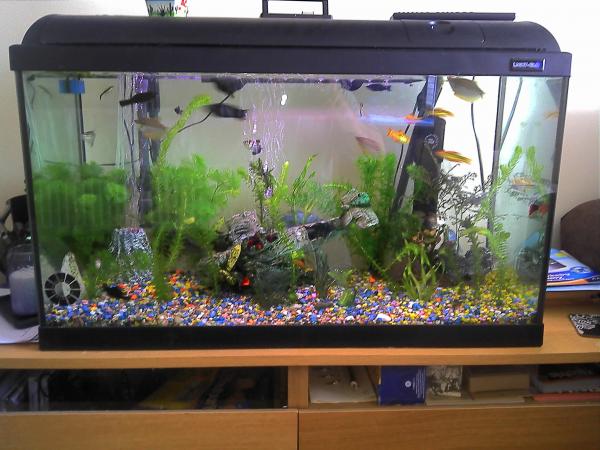Standard fish tanks are fantastic when you’re a child. Getting your basic fish bowl, adding your multi-coloured stones to the bottom and choosing the healthiest looking goldfish in the pet shop. All great fun. But when you’re that little bit older, or perhaps a younger tropical fish enthusiast, you want a more elaborate set-up that’s somewhat more professional and impressive. Tropical fish tanks are ideal because they look absolutely beautiful. The amount of fish to choose from is endless, and if you set the tank upright and do your research you can have a rainbow of stunning creatures swimming around your tank in no time.

Here are some easy tips to help you set up a tropical aquarium:
Where Is It Going?
When you choose where your aquarium is going to go, you must make sure you spend time thinking carefully about it.
Noise
First and foremost the fish shouldn’t be near anything that omits a lot of noise. So the tank shouldn’t be right next to the TV in the front room, or in a room where music is played in full blast. Any fish absolutely hate loud noise because they feel the vibrations of it, which makes them really stressed.
Heat
The aquarium should also be kept away from all heat sources. You’ll be using an aquarium heater from Reef Perfect to keep your fish at the right temperature, so you don’t want to adjust that temperature with external heating otherwise you could make your fish really poorly.
Light
A proper tropical aquarium will have its own light setup, so shouldn’t be placed near any direct light sources. Direct sunlight may also heat your tank water up (more than the recommended temperature) and make your fish unwell.
Surface
The surface the fish tank is on should be completely level. If it isn’t, additional stress will be placed on the side of the tank that is leaning which could result in the glass cracking or even exploding after a certain amount of time. You should also ensure that the surface you place the fish tank on is strong enough to cope with the weight of the tank.
Preparing The Tank
When you’re preparing your tank, you should have already received plenty of advice from the stockist if you’re purchased it from a shop. However, if you’ve purchased it online you should make sure you’ve done all the appropriate research before setting it up, as setting it up is the tricky part.
Clean
Before you do anything else, you’ll need to make sure the inside of the tank is clean. Do not use any bleach or disinfectant products as the residue will stay inside the tank and may kill your fish or make them unwell. Simply use a clean sponge or cloth and some warm water.
Basics
You’ll need to fill the bottom of your aquarium with sand or gravel, ensuring that those products have been made specifically for aquariums or they could make your fish ill or cloud your water. Before you place the sand or gravel in the tank you must rinse it thoroughly until the water you are rinsing it with runs clear.
Decorating
It’s down to you how you want your tank to look, which is really fun! You could have large tiki style ornaments and create a hawaiian feel, or you could add coral style ornaments to recreate your very own reef. You can also choose between real or fake plants depending on your taste, both have their pros and cons and both should be added after half the water is in the tank and the electrics are set up.
Whatever style you choose, make sure everything you buy is intended for an aquarium.
The Electrics
The basic electric equipment for a tropical aquarium is fairly simple. Once you have a basic set up you can then move on to more elaborate pieces of equipment.
You will need a filter, heater, lighting, airstone, air pump, check valve and thermometer. Choosing the right heater is really important as tropical fish need warm water to survive. You’ll want your water temperature to be around 21 to 28 degrees for your basic setup, but the person you buy your fish from should be able to advise you accordingly.
Once the electrics are set up and the tank is set up, the water can then be added.
Remember, the setup of a tropical fish tank can vary greatly depending on the equipment you buy, the size of your tank and the fish community you hope to achieve. Remember to do your research before you invest in any equipment.
